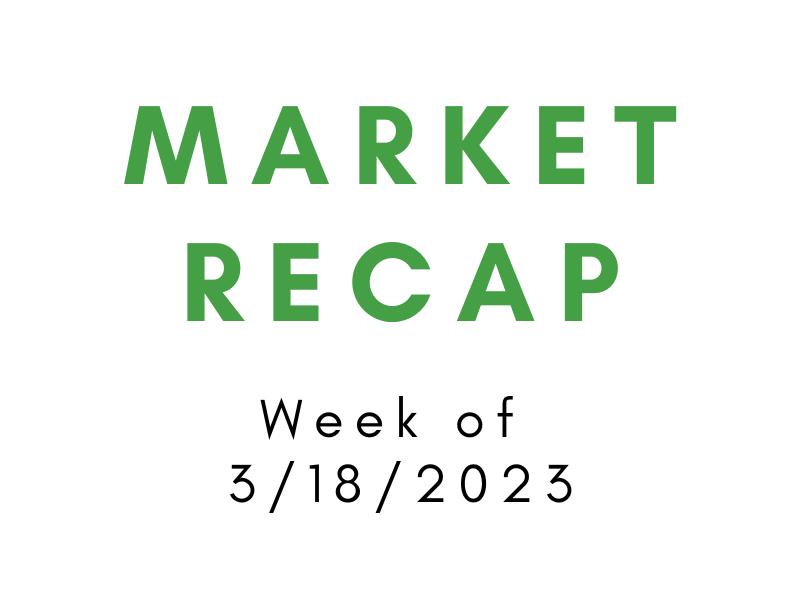||

The past week summarized in three headlines.
1. Roller Coaster Ride
Last week was a bit of a rollercoaster ride for the markets as the S&P 500 and NASDAQ regained some ground lost in the previous week’s sell-off, but the Dow fell slightly. This was largely due to instability in segments of the U.S. and European banking industries, which kept investors on edge. The week’s market volatility was primarily driven by the fallout from two U.S. bank failures and stresses at a midsize lender that secured a $30 billion deposit pledge on Thursday from a consortium of 11 large banks. Additionally, a troubled European bank received emergency assistance from Switzerland’s central bank. The price of U.S. crude oil also took a hit, falling below $67 per barrel on Friday and slumping to the lowest level in more than 15 months. The 13% drop for the week was due to instability in segments of the banking industry adding to recessionary fears, which could weigh on demand for oil. However, it wasn’t all bad news last week. U.S. inflation fell for the eighth consecutive month, slipping to the lowest level since September 2021. The government’s Consumer Price Index recorded a 6.0% annual rate in February, down from 6.4% the previous month and in line with most economists’ expectations. Meanwhile, cryptocurrency enthusiasts had reason to celebrate as the price of Bitcoin rose to nearly $27,000 on Friday, its highest level since last June. The most widely traded cryptocurrency surged 34% for the week, and on a year-to-date basis, Bitcoin was up 61% as of Friday.
2. The Collapse of the Bank
Silicon Valley Bank and Signature Bank recently experienced rapid failures, leading to panic withdrawals by depositors. The failures at both banks were among the three largest in US banking history. Although the banking industry has been holding record levels of excess reserves, these banks faced interest rate risk and liquidity risk, which caused their downfall. Interest rate risk is when rates increase rapidly within a short period, leading to a drop in the market value of fixed-income securities. SVB had 55% of its assets invested in fixed-income securities, while Signature had just over 5% of its assets in cash. Liquidity risk is the risk that a bank won’t be able to meet its obligations when they come due without incurring losses. Both banks had a significant number of uninsured deposits, which caused panic withdrawals and further loss of confidence. Although the US government has backed all deposits of SVB and Signature regardless of their size, the banking crisis is far from over, with over $1 trillion of bank deposits currently uninsured.
3. Money Multiplier Effect
The concept of the multiplier effect is an important one in economics, as it helps to explain how changes in spending or investment can have a magnified impact on the economy as a whole. The multiplier effect is often used to measure the impact of changes in government spending or monetary policy on economic growth and job creation. There are several different types of multipliers that economists use to analyze the effects of different types of investments or spending. The most basic multiplier is calculated as the change in income divided by the change in spending, and is often used by companies to assess the efficiency of their investments. The Keynesian multiplier is another important concept in economics, and is based on the idea that increases in government spending can have a positive impact on economic growth and job creation. This theory is based on the belief that increased government spending leads to increased demand for goods and services, which in turn leads to increased employment and economic growth.In addition to the Keynesian multiplier, there are other types of multipliers that are used to measure the impact of different types of investments or spending. These include the deposit multiplier, fiscal multiplier, equity multiplier, and earnings multiplier. Another important concept related to the multiplier effect is the money supply multiplier, which is used to measure the impact of changes in bank lending on the money supply. The money supply multiplier is a key concept in modern fractional reserve banking, and is used by economists and bankers to understand the impact of changes in the reserve requirement on the money supply.
Summary:
Last week saw market volatility due to instability in the US and European banking industries. US inflation fell for the eighth consecutive month, while Bitcoin price rose. Silicon Valley Bank and Signature Bank collapsed due to interest rate and liquidity risks, leading to panic withdrawals by depositors. The concept of the multiplier effect is an important one in economics, used to measure the impact of changes in spending or investment on the economy.
||
---------------------------
By: Sahil Kapadia
Title: Week of 3/18/2023
Sourced From: streetfins.com/week-of-3-18-2023/
Published Date: Sun, 19 Mar 2023 01:18:06 +0000
Read More
Did you miss our previous article...
https://peaceofmindinvesting.com/clubs/utma-and-ugma-accounts-pros-cons-and-rules
.png) InvestingStocksToolsClubsVideosPrivacy PolicyTerms And Conditions
InvestingStocksToolsClubsVideosPrivacy PolicyTerms And Conditions
